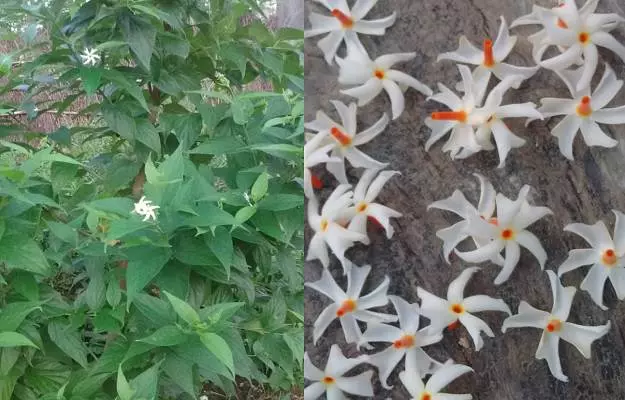Harsingar or Parijat is a flowering plant of high ornamental and medicinal value. The soothing and calming fragrance of Its beautiful white flowers is loved and cherished by many. In Ayurveda, harsingar is highly placed for its varied healing benefits. Commonly known as parijat or night-blooming jasmine, this tree has a mystical place in Indian mythology and folklore. Mentions of parijat plant and flowers are found in Bhagwat Gita and Harivamsa Purana. According to Indian mythological literature, Parijat is a tree from heaven. You’ll be curious to know that parijat tree only blooms at night and is known to shed all its flowers in the morning. In fact, it’s famously called as "Raat Ki Rani". Interestingly, the botanical name of harsingar plant translates to "tree of sorrow".
Harsingar tree or parijat could grow either as a shrub or a tree. The shrub can grow up to a height of 10-11m and it has a rather rough bark which is flakey and grey in shade. Leaves of this plant are hairy and long, while its white flowers grow in clusters at the top of its branches. Harsingar fruit is a round or heart-shaped capsule which is generally brown in colour. This plant requires partial shade to grow and isn’t much demanding when it comes to everyday care.
Some facts about harsingar:
- Botanical name: Nyctanthes arbor-tristis
- Family: Oleaceae
- Sanskrit name: Parijat, Shefali, Shefalika
- Common name: Parijat, Harsingar, Tree of sorrow, Queen of night, Night jasmine, Coral jasmine, Shuili, Raat ki Rani
- Parts used: Leaves, flowers, seeds
- Native region and geographical distribution: Harsingar is a native of South Asia. It is mainly found in parts of Northern India, Nepal, Pakistan, and Thailand.
Did you know?
Harsingar flowers are the official flower of the Indian state of West Bengal. It is used in Hindu festivals as an offering for Goddess Durga and Lord Vishnu.










































